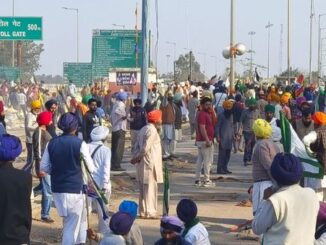
Consider this: India‘s per capita GDP still hovers around $2,480, compared to Japan‘s $33K or Germany‘s $54K
“A forward-looking economic agenda would include a progressive wealth tax, higher marginal rates on capital gains and closing of corporate loopholes that erode the tax base. Expanding public investment in child and elder care infrastructure could unlock female labor force participation while generating millions of dignified jobs. Moreover, formalizing informal employment through universal social protection floors, streamlined labor codes and digital inclusion can offer security without sacrificing flexibility. Fiscal policy must evolve beyond scarcity-thinking and towards rights-based provisioning, treating education, health and employment not as charity but as citizenship guarantees.”
Also Read: https://www.theindianpanorama.news/opinion/modi-selling-rising-gdp-as-a-sign-of-prosperity-to-the-deprived-masses-of-india/

India has taken an economic leap, overtaking Japan to become the fourth largest economy in nominal GDP. At $4 trillion, the Indian economic landscape sits just behind the US, China and Germany. But size-driven growth alone does not confer greatness. Nor does scale guarantee substance. In the Indian context, economic size also has very little to offer on distributive equity. Beneath the din lies a quieter, sobering narrative, one of persistent inequality, vast informal labor, low human development and frayed social safety nets. India’s economic expansion remains acutely uneven in distribution and experience. It has produced islands of affluence in a sea of precarity.
This is not to deny the real progress India has made. But we must ask: aspiration fulfilled for whom? Because when growth is judged by volume rather than value and size by nominal metrics rather than lived outcomes, it risks becoming a mirage, a spectacle of progress untethered from social reality.
Consider this: India’s per capita GDP still hovers around $2,480, compared to Japan’s $33K or Germany’s $54K, and lagging behind even Vietnam and the Philippines. India’s $4-trillion GDP, when divided among its 1.4 billion citizens, shows cracks. Thus, India’s average citizen earns approximately 1/22nd of a German and slightly less than 1/14th of a Japanese. The symbolism is striking: two nations once seen as economic underdogs now offer a higher average standard of living than the world’s fourth largest economy.
This is a call to distinguish economic size from developmental depth. This problem is conceptual. Aggregate GDP is a blunt instrument, better suited to measuring production than prosperity. It counts luxury condominiums and slums at the same time, billionaires and daily wagers alike and tells us who owns assets, who can access formal credit, who inherits safety nets and who remains locked out.
In India, economic mobility is still tethered to geography, caste, gender and inheritance. Without meaningful redistribution, through progressive taxation, asset reform or targeted social investment, the system will remain one of exclusion rather than inclusion.
According to the World Inequality Report, the top 1 per cent of Indians command 22.6 per cent of the national income and a staggering 40.1 per cent of the wealth. The bottom 50 per cent earn just 15 per cent of the income and hold a mere 6.4 per cent of wealth. In Germany and Japan, the bottom 50 per cent hold nearly 20 per cent of national income.
The imbalance in India’s rise is most visible in its labor market. This is a paradox where growth coexists with joblessness and expansion leaves the majority of workers behind. Despite over three decades of liberalization, India’s growth model remains stubbornly capital-intensive, privileging high-margin sectors such as finance, IT and real estate while neglecting the labor-absorbing capacity of manufacturing, agriculture and small-scale enterprises. The result? A “jobless growth” trajectory that fuels GDP numbers but fails to create meaningful employment for millions.
Over 90 per cent of the workforce is employed informally, without social security, pensions or formal contracts. This becomes a structural fault line. It depresses labor productivity, narrows the tax base and exacerbates inequality by excluding the majority from rights-based protections.
According to the India Employment Report 2024, youth unemployment has risen from 5.7 per cent in 2000 to 17.5 per cent in 2019. The quality of jobs remains poor, often informal, low-wage and devoid of upward mobility. More alarming is the female labor force participation, which languishes below 25 per cent. Cultural constraints, safety concerns, poor transport and a lack of childcare facilities play a role, but so does an architecture that favors capital subsidies over investments in public infrastructure and services. Japan and Germany, despite ageing populations, have increased women’s workforce engagement through robust maternity benefits, subsidized childcare and flexible work arrangements.
Meanwhile, India’s middle class is under increasing strain. Household debt surged to 42.9 per cent of GDP by mid-2024 from 36.6 per cent in June 2021, while household savings fell from 84 per cent of total savings in 2000 to 61 per cent in 2023.
The disconnect between India’s capital-rich growth and labor-poor reality underscores the need for a rethink.
With a tax-to-GDP ratio of just 6.8 per cent as of December 2024 (it was 9.1 per cent in September), India finds itself with too little fiscal muscle to fund ambitious public goods or progressive welfare. Germany’s tax-to-GDP ratio is 38 per cent and Japan’s 34.1 per cent. This reflects not only the tax capacity of the state but also the tax intention.
This constraint is compounded by the narrow base of direct taxation. India has hesitated to meaningfully tax wealth, inheritances or large capital gains, mechanisms used widely in OECD economies to fund equitable growth. Welfare schemes provide only subsistence and not any structural uplift. The absence of fiscal federalism also hobbles inclusive development. State governments, responsible for health, education and infrastructure, remain financially starved and dependent on the Centre’s transfers. This limits the potential for targeted interventions that account for regional disparities in poverty, caste exclusion and gender gaps.
A forward-looking economic agenda would include a progressive wealth tax, higher marginal rates on capital gains and closing of corporate loopholes that erode the tax base. Expanding public investment in child and elder care infrastructure could unlock female labor force participation while generating millions of dignified jobs. Moreover, formalizing informal employment through universal social protection floors, streamlined labor codes and digital inclusion can offer security without sacrificing flexibility. Fiscal policy must evolve beyond scarcity-thinking and towards rights-based provisioning, treating education, health and employment not as charity but as citizenship guarantees.
If India is to truly ascend not just in rankings but also in the lived reality of its people, it needs a structural course-correction. It must resolve to building an economy not just of the few, but for the many.
(Deepanshu Mohan is a Professor of Economics and Dean, IDEAS, Office of Interdisciplinary Studies, and Director, Centre for New Economics Studies, O.P. Jindal Global University.)





Be the first to comment